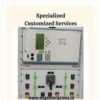Relay Testing and Commissioning Services
Description
Relay Testing and Commissioning Services
We offer the Relay Testing and Commissioning Services of all make of relays with all applications. Our team is capable of doing testing of relays with very advance test kits like Omicron, Doble, Megger, etc. We also carry out regular maintenance and calibration jobs of Numerical as well as Electromechanical Relays.
Substation Erection, Relay Testing and Commissioning Services
Our team of experts can give you all kinds of ETC services for your substation. We can work all across the voltage levels LV,MV,HV, and EHV. We carry out ETC for AIS as well GIS substations. We have our own advanced testing equipment to carry out necessary testing at substation and to get the work done
quickly without depending on anybody.
We can also give necessary support for integration of relays into existing SCADA or New SCADA.
We provide testing services for following relays:
- Line Distance Relay
- Line Differential Relay
- Transformer Differential Relay
- Motor/Generator Protection Relay
- Directional Relay
- REF Relay
- Transformer/Motor/Generator Relay
- Bus bar Protection Relay
- Feeder Protection Relay
WHAT IS PROTECTION RELAY AND WHY TESTING IS IMPORTANT
Protection relays are fault detection devices in power system, which senses the faults by using current and voltage sensors like CT and/or PT and further controls the related circuit breakers to isolate or minimise the fault.
Protection relays act as a brain and take decisions based on the settings instruction given to it. Protection relays and its associated components like Master trip Relays or Auxiliary relays which in totality defines protection schemes. All these equipment are subject to aging and their characteristics are likely to change. Also load conditions may change and for this we need to check whether our existing protection scheme is suitable or not. Because a protection scheme only operates under fault conditions, defects may not be revealed for a significant period of time, until a fault occurs.
Like the saying prevention is better than cure, the timely protection relay testing will reveal catastrophic failures which would have prevented the relay from performing when called upon to operate, and properly maintained records will reveal any trends which could lead to such failures. Periodic Maintenance Checks are required to identify equipment failures and degradation in service so that corrective action can be taken.. Regular testing assists in detecting faults that would otherwise remain undetected until a fault occurs.
HOW PROTECTION RELAY TESTING IS DONE?
A good set of testing equipment and relay tools are used by our inspectors. Several manufacturers now produce portable relay test sets which provide reliable and accurate results.
Following are the various steps that we perform for protection relay testing:
VISUAL INSPECTION OF PROTECTION RELAY TESTING:
Before the relay cover is removed, a visual check of the cover can reveal valuable information as well as prevent possible trouble. First, of course, excessive dust, dirt or metallic material deposited on the cover should be noted and removed. Removing such material will prevent it from entering the relay when the cover is removed. The presence of such deposits may call attention to the need for some form of air filtering at the station. Included in this visual inspection should be a check for loose connections, broken studs, burned insulation, and dirty contacts. Each relay should be checked to be in agreement with its setting sheet.
MECHANICAL INSPECTION OF PROTECTION RELAY TESTING:
All connections should be tight. If several connections are found loose, indicating excessive vibration should be corrected. All gaps should be free of foreign material, and should excessive foreign material be found, inspection of the gasket is required. Moving gaps (contact gaps, armature gaps, etc.) should be measured and the values compared with previous measurements. Should there be a large variation in these measurements, excessive wear may be indicated, in which case the worn parts should be replaced.
ELECTRICAL TYPE PROTECTION RELAY TESTING:
Relay Functional/Operation Tests
Using Secondary injection kits we perform functional/Operation tests. In this test not only protection relay but all the equipment comprising protection scheme such as Master trip relays, Supervision relays, Auxiliary relays, Annunciators, etc get tested. The functional tests consist of applying the appropriate inputs to the relay under test and measuring the performance to determine if it meets the specification. With the use of advanced Test Kits we can generate reports instantly. The kits software are equipped with some advanced features and in built test templates to facilitate very accurate test results.
Various Protection Schemes along with their specific characteristics can be Tested by means of these test kits like
Overcurrent Protection –
Under/Over Voltage Protections
Under/Over Frequency Protections
Rate of change of Frequency
Synchrocheck
Auto Reclosing
Directional Overcurrent Protection
Differential Protections for Line, Cable, Transformer, Generator, Motors
Distance/Impedance Protection for Lines, Cable, Generators
Generator Protections
Motor Protections
Busbar Protections
PERIODIC MAINTENANCE TESTS FOR PROTECTION RELAYS
Periodic testing is necessary to ensure that a protection scheme continues to provide satisfactory performance for many years after installation. All equipment subject to gradual degradation with time, and regular testing is intended to identify the equipment concerned so that remedial actions can be taken before scheme maloperation occurs. However, due care should be taken in this task, otherwise faults may be introduced as a direct result of the remedial work.
The self-checking facilities of numerical relays assist in minimising failures due to faulty relays. Defects in secondary wiring and incorrect connections are virtually eliminated if proper commissioning after scheme installation/alteration is carried out. The possibility of incorrect settings is minimised by regular reviews of relay settings. Network fault levels change over time and hence setting calculations may need to be revised. Switching and testing errors are minimised by adequate training of personnel, use of proven software, and well- designed systematic working procedures. All of these can be said to be within the control of the user.
The remaining three causes switching errors, application shortcomings, pilot wire faults, etc. are not controllable, while two of these three are unavoidable – engineering is not science and there will always be situations that a protection relay cannot reasonably be expected to cover at an affordable cost.
Although protection equipment should be in condition when first put into service, problems develop unchecked and not revealed because of infrequent operation. With digital and numerical relays the in-built self-testing routines can be expected to reveal and annunciate most faults, but this does not cover any other components that, together, comprise protection scheme. Regular inspection and testing of protection scheme is therefore required. It is desirable to carry out maintenance on protection equipment at times when the associated power apparatus is out of service. This is facilitated by co-operation between the maintenance staff concerned and the network operations control centre.








Reviews
There are no reviews yet.